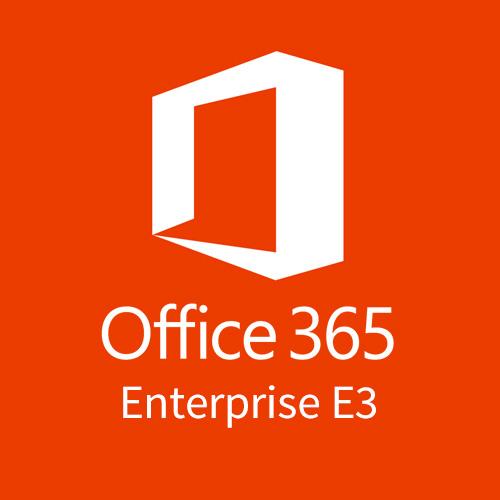Office 365 Enterprise Plan E3 includes all features but not limited to: Office suite Latest versions of: Word, Excel, PowerPoint, Outlook, OneNote, Publisher, Skype for Business and Access. Office on PCs, tablets, and phones Full Office experience across PCs, Macs, tablets, and most mobile devices. Each user can install Office on 5 PCs/Macs, 5. See Buy licenses for your Office 365 for business subscription and Assign licenses to users in Office 365 for business. In some cases, an admin may need to add an Microsoft 365 plan or switch you to an Microsoft 365 plan that includes the services you need. See Switch to a different Office 365.
- Only minor Office document editing and none of the above? Office 365 E1; Cloud Storage in Office 365 E1 vs E3. If we look into the standard services of Office 365, then there is almost no difference between the E1 and the E3 version. But there is one difference between the two, and that is how much personal cloud storage you get.
- Office 365 E3 is the most affordable way to get premium versions of the Office apps and services for enterprise users. With E3, you have full use of: These are the desktop versions of the apps, which means you get all the premium features and full offline access across all your devices. Each user can install Office 365 E3 on up to five.
Microsoft 365 Business Premium has everything you need for your small business, combining the best-in-class cloud-based productivity apps with simple device management and security. If you currently have an Office 365 E3 subscription, but don't have more than 300 employees, consider switching to Microsoft 365 Business Premium for added security features.
Office 365 E3 Intune
Migrating is easy: First you switch licenses and all your data and user information in your current subscription is maintained. After the migration, you'll need to set up the features that are added in Microsoft 365 Business Premium.
Differences between Office 365 E3 and Microsoft 365 Business Premium
This table shows the differences between Microsoft 365 Business Premium and Office 365 E3.
| Feature | Support in Microsoft 365 Business Premium | Support in Office 365 E3 |
|---|---|---|
| On-premises | ||
| Office apps1 | Microsoft 365 Apps for business | Microsoft 365 Apps for enterprise |
| Cloud productivity apps | ||
| Exchange Online and Outlook | 50 GB storage limit per mailbox and unlimited Exchange Online Archiving | 100 GB storage limit per mailbox and unlimited Exchange Online Archiving |
| Teams | ||
| OneDrive for Business | 1 TB storage limit per user | Unlimited |
| Yammer, SharePoint Online, Planner, Stream | ||
| StaffHub | ||
| MileIQ | ||
| Threat Protection | ||
| Defender for Office 365 Plan 1 | Not included, but can be added on | |
| Identity management | ||
| Self-service password reset for hybrid Azure Active Directory (Azure AD) accounts, Azure AD multi-factor authentication (MFA), Conditional Access, password writeback for on-premises identities | ||
| Device and app management | ||
| Microsoft Intune, Windows AutoPilot | ||
| Shared computer activation | ||
| Upgrade rights to Windows 10 Pro from Win 7/8.1 Pro licenses | ||
| Information protection | ||
| Office 365 Data Loss Prevention | ||
| Azure Information Protection Plan 1, BitLocker enforcement | ||
| Azure Information Protection Plan 1, Sensitivity labels | ||
| Client Access License (CAL rights) | ||
| Enterprise CAL Suite (Exchange, SharePoint, Skype) |
1 The Microsoft 365 Business Premium version of the Office apps doesn't include volume activation through Group Policy, app telemetry, update controls, spreadsheet compare and inquire, or business Intelligence.
Migration
To migrate your subscription, see Change plans manually for instructions if you want to move just a few people to Microsoft 365 Business Premium. You can also upgrade everyone automatically, or work with a partner to move your E3 subscription and licenses to a Microsoft 365 Business Premium subscription.The following sections describe the changes you need to make, if any, and what you can do after the migration.
Office 365 E3 subscription configuration and data
You don't need to do any changes to your current subscription or data before migrating, which includes:

- Subscription configuration, such as DNS records and domain names.
- User and group accounts and authentication settings, such as multi factor authentication or conditional access policies.
- Productivity service configurations and their data, such as Teams, Exchange Online mailboxes, SharePoint Online sites, OneDrive for Business folders, and OneNote notebooks.
- Office applications will scale automatically. Office 365 modern licensing will check the user’s license assignment every 72 hours and will convert Office applications to the version that matches the user subscription.
Windows 10

If your Windows aren't already on Windows Pro Creator update, upgrade them to Windows Pro Creators Update.
Set up policies to protect user devices and files
Note
Office 365 E3
If you set up Office 365 MDM policies and devices, those devices will be listed on the Devices page in the Microsoft 365 admin center. Any policies you set up will show up in the list of classic policies in the Intune portal.
After you have assigned licenses to Microsoft 365 Business Premium, you can start protecting the users' devices and files.

If you upgraded everyone in your organization to Microsoft 365 Business Premium, you'll see the setup wizard on the Home page, and can follow the Set up Microsoft 365 Business Premium in the setup wizard steps to protect files and mobile devices.
You can also complete these steps on the Devices page:
In the admin center, in the left nav, go to Devices > Policies.
On the Device policies page, choose Add.
In the Add policy pane give the policy a name, and then choose a Policy type from the drop-down.
You can set up application policies for protecting files on Android and iPhone devices, as well as Windows 10, and you can set up device configuration policies for company owned Windows 10 devices. Americanfuture laptops & desktops driver download. See the following links for details:

- Once you set up policies, you and your employees can set up devices:
See Set up Windows devices for Microsoft 365 Business Premium users for steps for Windows devices.
See Set up mobile devices for Microsoft 365 Business Premium users for steps for Android phones and iPhones. American idiot guitar pro.
Mailbox Size
Microsoft 365 Business Premium has a 50 GB storage limit as it uses Exchange Online Plan 1. While migrating to Microsoft 365 Business Premium, if any of your users exceed 50 GB of mailbox storage, it is recommended that you assign this user an Exchange Online Plan 2 and remove the Exchange Online Plan 1 as it's not feasible to assign both.
Threat protection

Office 365
After migrating to Microsoft 365 Business Premium, you have Defender for Office 365. See Microsoft Defender for Office 365 for an overview. To set up, see set up Safe Links, set up Safe Attachments, and set up Anti-phishing in Defender for Office 365.
Office 365 E3 Enterprise
Sensitivity labels
Office 365 E3 Apps
To start using sensitivity labels, see Overview of sensitivity labels and create and manage sensitivity labels video.
